Influences of Land Use Change on Baseflow in Mountainous Watersheds
Abstract
:1. Introduction
2. Study Area and Methods
2.1. Study Area
2.2. Methods
2.2.1. Data Collection
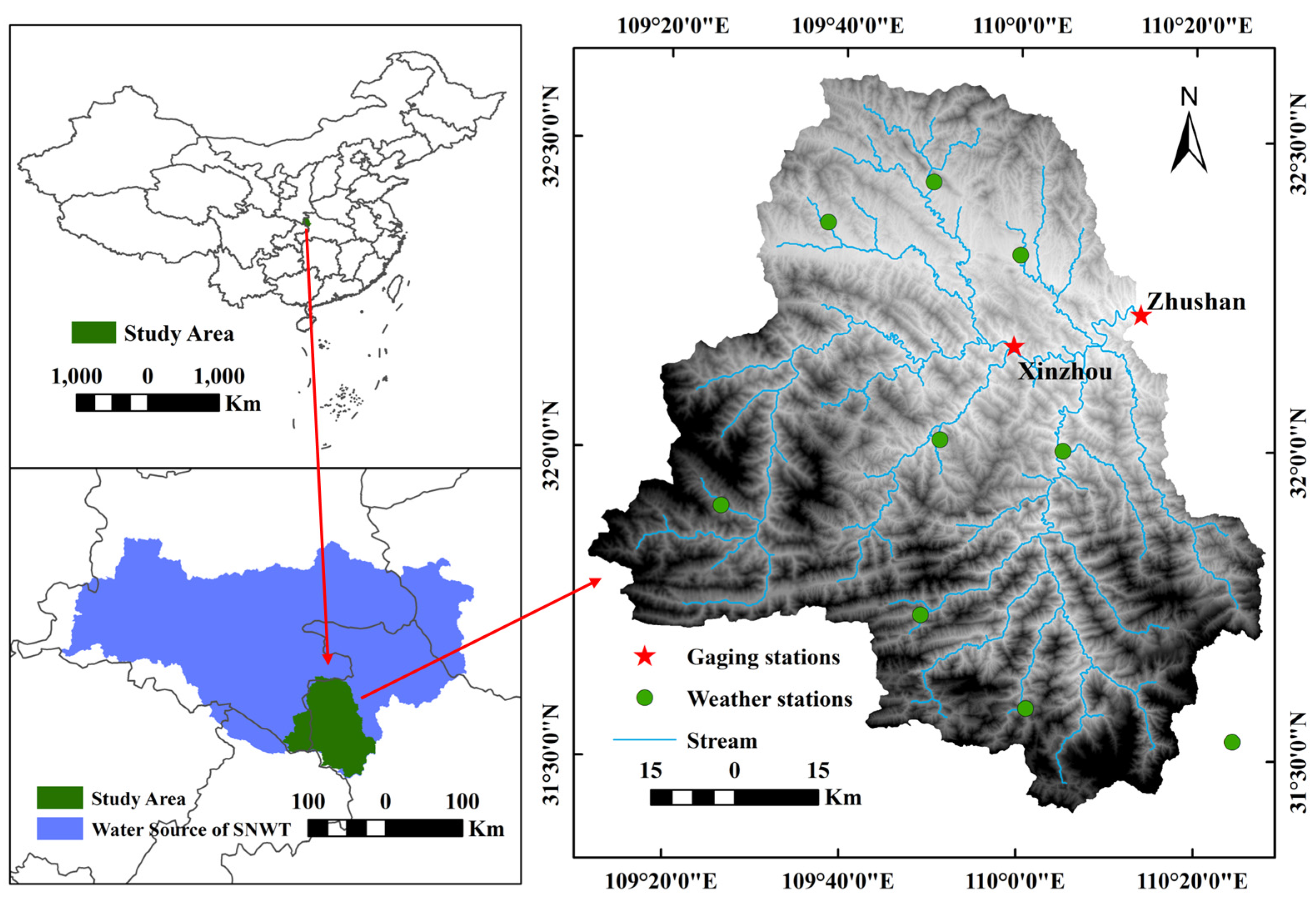

2.2.2. Baseflow Separation
2.2.3. SWAT Model Setup
2.2.4. SWAT Calibration for Un-Gauged Sub-Watershed Baseflow
| Parameter Database | Parameter | Definition | Optimal Value |
|---|---|---|---|
| .bsn | ESCO | Soil evaporation compensation factor | 1 |
| EPCO | Plant water uptake compensation factor | 1 | |
| SURLAG | Surface runoff lag time | 2 | |
| .GW | GW_DELAY | Delay days | 10 |
| GW_REVAP | Re-evaporation coefficient | 0.05 | |
| ALPHA_BF | Baseflow alpha factor | 0.5 | |
| .soil | SOL_AWC | Available soil water capacity | 0.2 |
| .sub | CH_N1 | Manning’s “n” of tributary channels | 0.1 |
| .rte | CH_N2 | Manning’s “n” of the main channel | 0.02 |
| .mgt | CN2 | SCS curve number | 39 (Forest) |
| 48 (Shrubland) | |||
| 68 (Grassland) | |||
| 81 (Farmland) | |||
| 89 (Urban) | |||
| 92 (Barren) | |||
| .GW | GWQMN | Threshold of return flow occurring in aquifer | 0 |
| RCHRGDP | Deep aquifer percolation factor | 0.05 | |
| .hru | SLSUBBSN | Slope length of the sub-basin | 1.1 |
| HRU_SLP | Slope of Hydrological Response Unit (HRU) | 0.1 |
2.2.5. Model Application
2.2.6. Statistical Analyses
3. Results and Discussion
3.1. Un-Gauged Sub-Watersheds Baseflow
| Stations | Period | ENS a | PBIAS b | R2 | Rating |
|---|---|---|---|---|---|
| Zhushan | Calibration (1971–1980) | 0.83 | 3.9 | 0.85 | Very good c |
| Validation (1981–1990) | 0.80 | 4.5 | 0.81 | Very good | |
| Overall (1971–1990) | 0.82 | 4.2 | 0.83 | Very good | |
| Xinzhou | Validation (1991–2000) | 0.77 | 1.5 | 0.87 | Very good |
| Overall (1991–2010) | 0.77 | 1.5 | 0.87 | Very good |
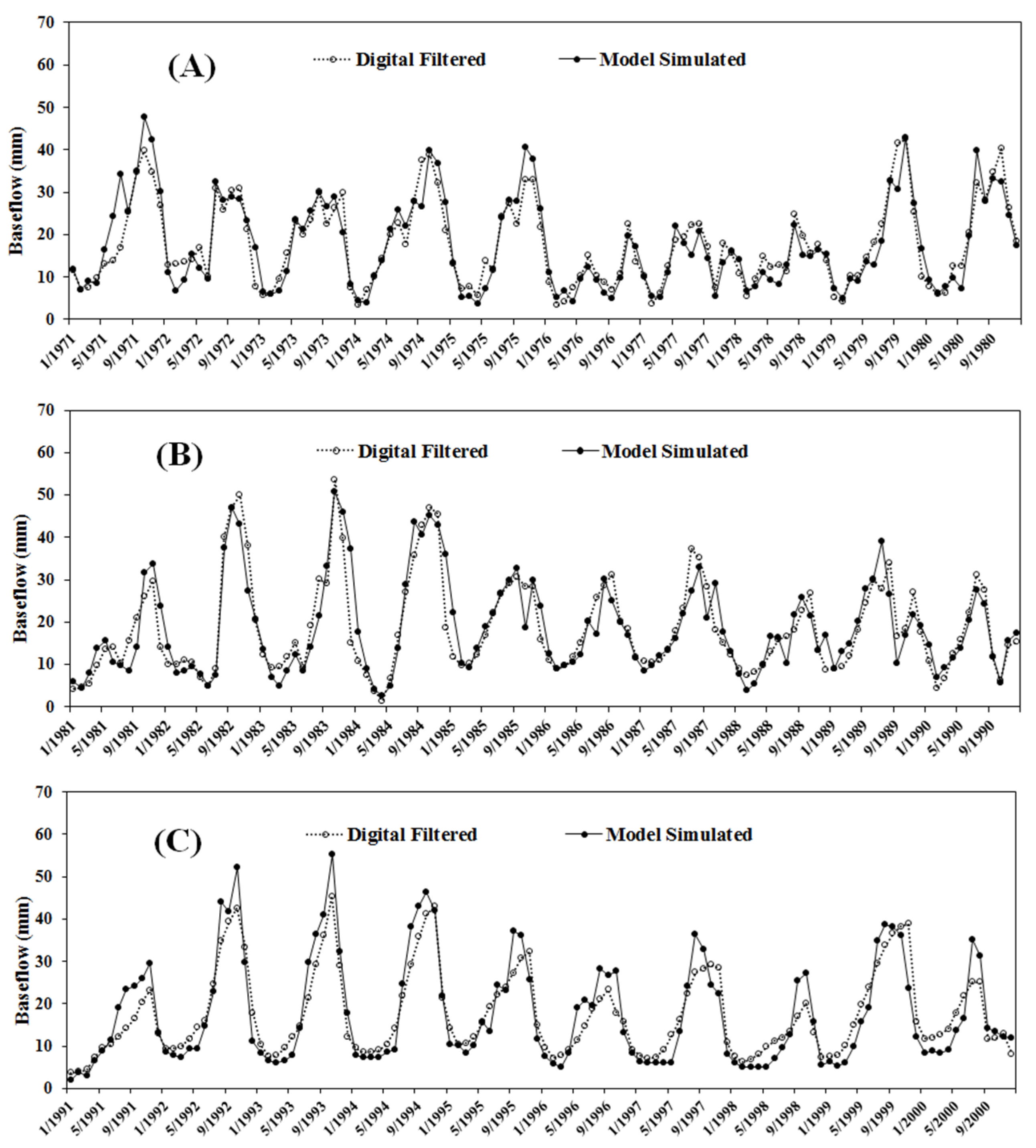
3.2. Temporal and Spatial Distribution of Baseflow
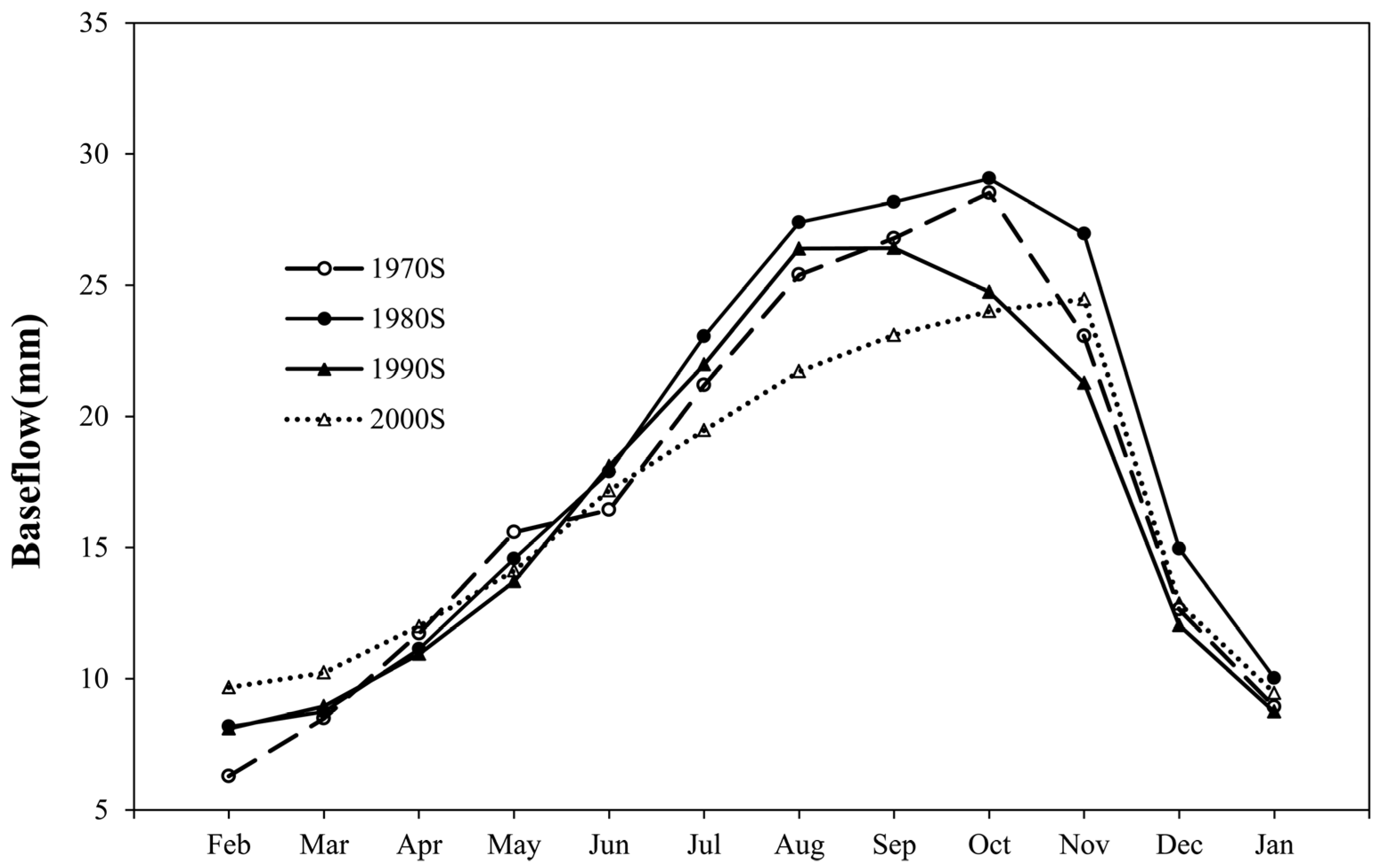

| Seasonal Baseflow | Land Use Scenarios | Robust Coefficient of Variation |
|---|---|---|
| Spring baseflow | 1978 | 216.8% |
| 2007 | 239.2% | |
| Summer baseflow | 1978 | 241.5% |
| 2007 | 260.4% | |
| Autumn baseflow | 1978 | 232.8% |
| 2007 | 234.5% | |
| Winter baseflow | 1978 | 219.3% |
| 2007 | 226.3% |
3.3. Influences of Forest and Other Land Use Changes on Baseflow
| Land Use (%) | 1978 | 1987 | 1999 | 2007 | 1978–1987 | 1987–1999 | 1999–2007 | 1978–2007 |
|---|---|---|---|---|---|---|---|---|
| Forest | 70.9 | 70.4 | 69.3 | 76.2 | −0.5 | −1.1 | +6.9 | +5.3 |
| Farmland | 9.8 | 10.2 | 13.6 | 5.8 | +0.4 | +3.4 | −7.8 | −4.0 |
| Urban | 0.8 | 0.9 | 1.1 | 1.4 | +0.1 | +0.2 | +0.4 | +0.6 |
| Grassland | 7.6 | 7.3 | 5.9 | 6.1 | −0.3 | −1.4 | +0.2 | −1.5 |
| Shrubland | 10.2 | 10.4 | 9.4 | 9.5 | −0.2 | +1.0 | −0.1 | −0.7 |
| Barren | 0.3 | 0.4 | 0.4 | 0.7 | +0.1 | 0 | +0.3 | +0.4 |
| Water | 0.4 | 0.4 | 0.3 | 0.3 | 0 | −0.1 | 0 | −0.1 |
| Land Use Maps | Land Use Types | Robust Coefficient of Variation |
|---|---|---|
| 1978 | Forest | 159.6% |
| Farmland | 350.0% | |
| Urban | 304.0% | |
| Grassland | 159.8% | |
| Shrubland | 223.1% | |
| Barren | 197.9% | |
| Water | 279.8% | |
| 2007 | Forest | 193.7% |
| Farmland | 394.8% | |
| Urban | 352.9% | |
| Grassland | 396.7% | |
| Shrubland | 203.5% | |
| Barren | 514.1% | |
| Water | 213.3% |
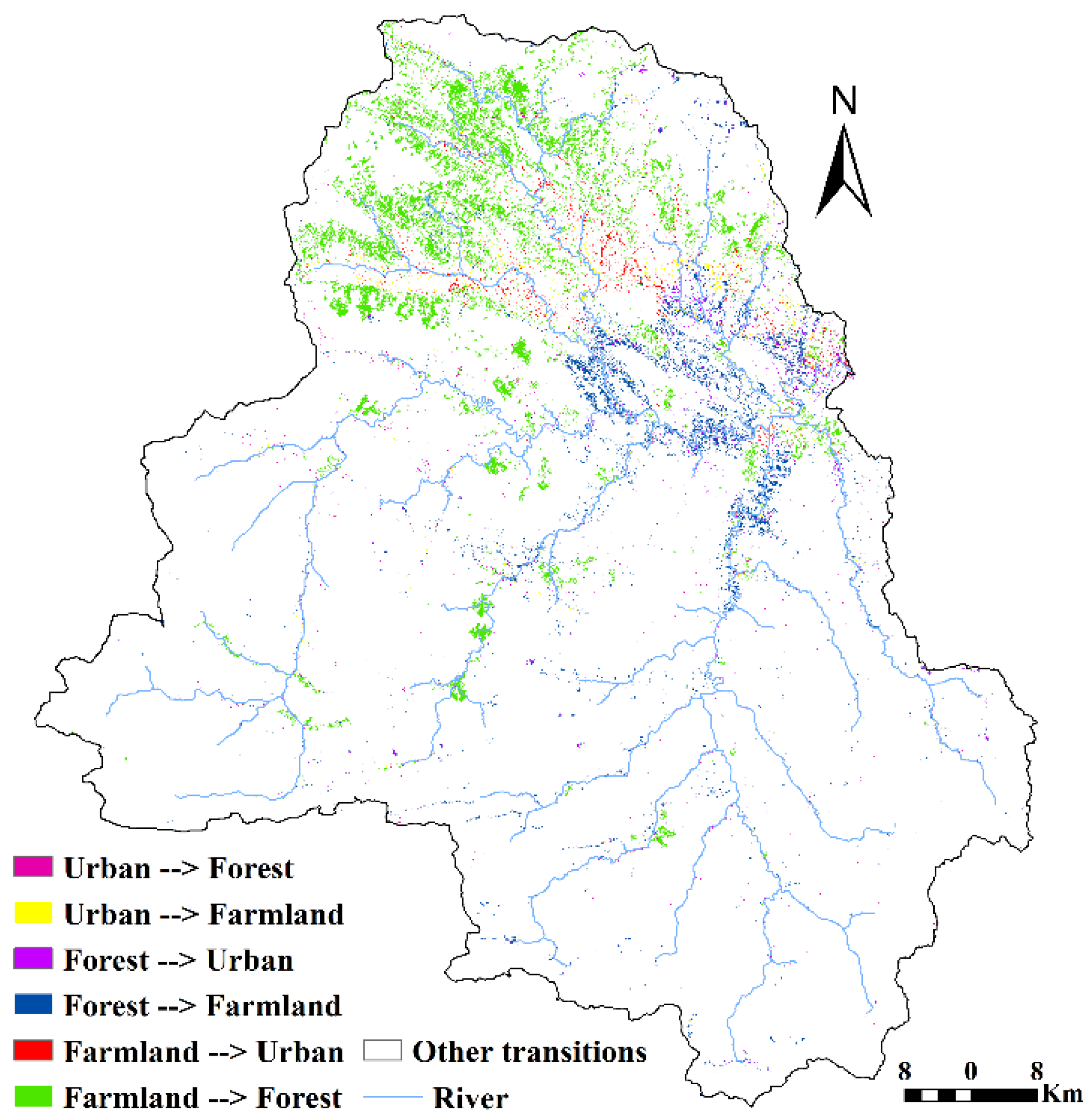
3.4. Contribution of Land Use Changes to Baseflow
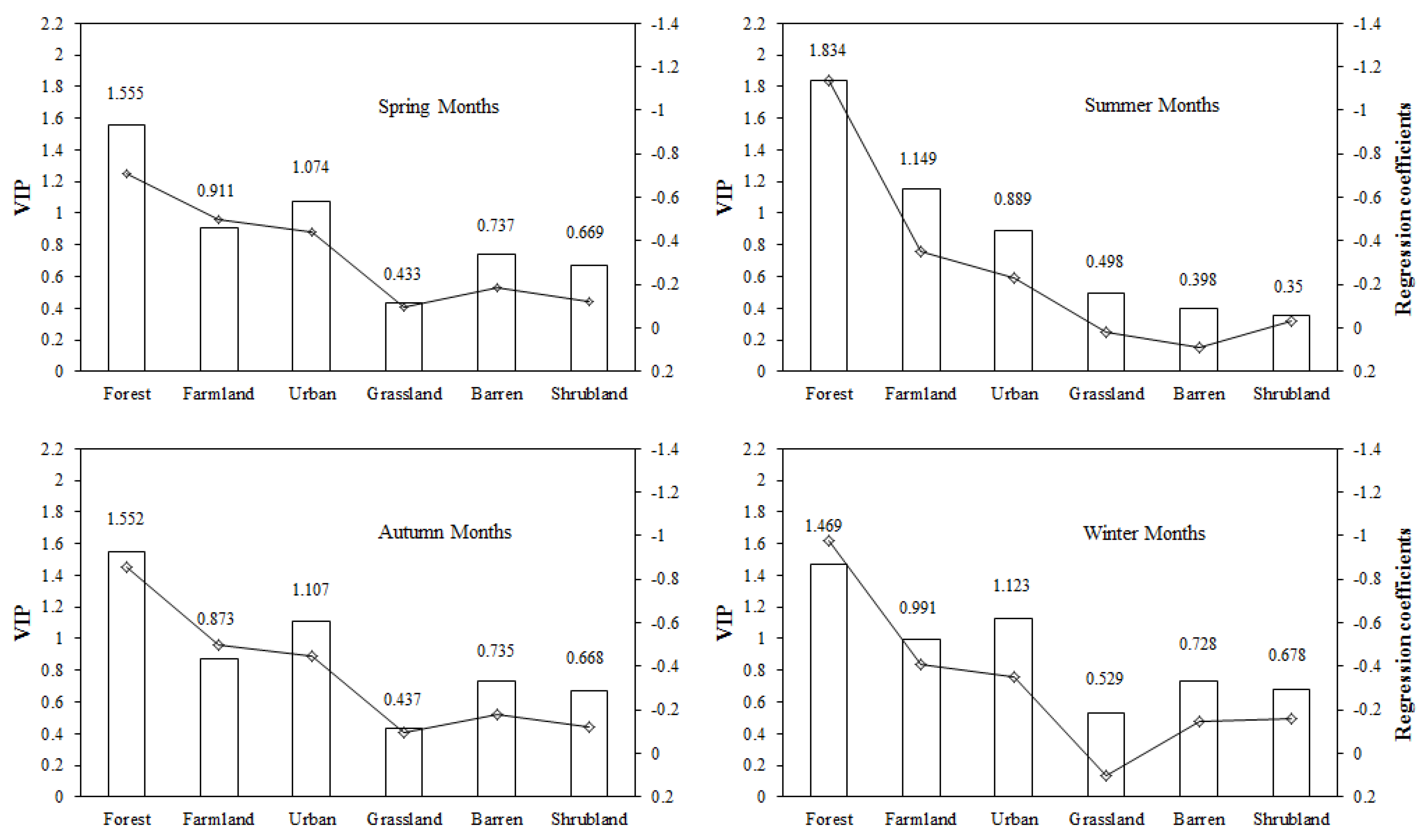
| Response Y | R2 a | Q2 b | Component | % of Explained Variability in Y | Cumulative Explained in Y (%) | RMSECV c | Q2cum d |
|---|---|---|---|---|---|---|---|
| Spring baseflow | 0.79 | 0.67 | 1 | 74.7 | 74.7 | 0.88 | 0.634 |
| 2 | 4.4 | 79.1 | 0.80 | 0.666 | |||
| 3 | 0.4 | 79.5 | 0.81 | 0.656 | |||
| Summer baseflow | 0.82 | 0.72 | 1 | 71.8 | 71.8 | 6.09 | 0.658 |
| 2 | 9.8 | 81.6 | 5.12 | 0.718 | |||
| 3 | 1.2 | 82.8 | 5.70 | 0.709 | |||
| Autumn baseflow | 0.79 | 0.68 | 1 | 74.4 | 74.4 | 0.88 | 0.644 |
| 2 | 4.4 | 78.8 | 0.80 | 0.682 | |||
| 3 | 0.4 | 79.2 | 0.81 | 0.667 | |||
| Winter baseflow | 0.71 | 0.55 | 1 | 69.1 | 69.1 | 1.29 | 0.597 |
| 2 | 2.2 | 71.3 | 1.26 | 0.547 | |||
| 3 | 0.1 | 71.4 | 1.27 | 0.494 |
4. Conclusions
Acknowledgments
Author Contributions
Conflicts of Interest
References
- Eckhardt, K. A comparison of baseflow indices, which were calculated with seven different baseflow separation methods. J. Hydrol. 2008, 352, 168–173. [Google Scholar] [CrossRef]
- Smakhtin, V.U. Low flow hydrology: A review. J. Hydrol. 2001, 240, 147–186. [Google Scholar] [CrossRef]
- Price, K. Effects of watershed topography, soils, land use, and climate on baseflow hydrology in humid regions: A review. Prog. Phys. Geogr. 2011, 35, 465–492. [Google Scholar] [CrossRef]
- Knox, J.C. Floodplain sedimentation in the Upper Mississippi Valley: Natural versus human accelerated. Geomorphology 2006, 79, 286–310. [Google Scholar] [CrossRef]
- Varis, O.; Vakkilainen, P. China’s 8 challenges to water resources management in the first quarter of the 21st Century. Geomorphology 2001, 41, 93–104. [Google Scholar] [CrossRef]
- Zhuang, D.F.; Deng, X.Z.; Zhan, J.Y.; Zhao, T. A study on the spatial distribution of land use change in Beijing. Geogr. Res. 2002, 21, 667–674. (In Chinese) [Google Scholar]
- Dou, X.; Chen, B.; Black, T.A.; Jassal, R.S.; Che, M. Impact of nitrogen fertilization on forest carbon sequestration and water loss in a chronosequence of three Douglas-fir stands in the pacific northwest. Forests 2015, 6, 1897–1921. [Google Scholar] [CrossRef]
- Nie, W.M.; Yuan, Y.P.; Kepner, W.; Nash, M.S.; Jackson, M.; Erickson, C. Assessing impacts of land use changes on hydrology for the upper San Pedro watershed. J. Hydrol. 2011, 407, 105–114. [Google Scholar] [CrossRef]
- Zhang, Y.K.; Schilling, K.E. Increasing streamflow and baseflow in Mississippi River since the 1940s: Effect of land use change. J. Hydrol. 2006, 324, 412–422. [Google Scholar] [CrossRef]
- Ma, X.; Xu, J.C.; Luo, Y.; Aggarwal, S.P.; Li, J.T. Response of hydrological processes to land-cover and climate changes in Kejie watershed, south-west China. Hydrol. Process. 2009, 23, 1179–1191. [Google Scholar] [CrossRef]
- Artita, K.S.; Kaini, P.; Nicklow, J.W. Examining the possibilities: Generating alternative watershed-scale BMP designs with evolutionary algorithms. Water Resour. Manag. 2013, 27, 3849–3863. [Google Scholar] [CrossRef]
- Zhou, F.; Xu, Y.; Chen, Y.; Xu, C.Y.; Gao, Y.; Du, J. Hydrological response to urbanization at different spatio-temporal scales simulated by coupling of CLUE-S and the SWAT model in the Yangtze River Delta region. J. Hydrol. 2013, 485, 113–125. [Google Scholar] [CrossRef]
- Luedeling, E.; Gassner, A. Partial least squares regression for analyzing walnut phenology in California. Agric. For. Meteorol. 2012, 158, 43–52. [Google Scholar] [CrossRef]
- Shi, Z.H.; Ai, L.; Li, X.; Huang, X.D.; Wu, G.L.; Liao, W. Partial least-squares regression for linking land-cover patterns to soil erosion and sediment yield in watersheds. J. Hydrol. 2013, 498, 165–176. [Google Scholar] [CrossRef]
- Abdi, H.; Williams, L.J. Principal component analysis. Wiley Interdiscip. Rev. Comput. Stat. 2010, 2, 433–459. [Google Scholar] [CrossRef]
- Geladi, P.; Sethson, B.; Nyström, J.; Lillhonga, T.; Lestander, T.; Burger, J. Chemometrics in spectroscopy. Spectrochim. Acta B At. Spectrosc. 2004, 59, 1347–1357. [Google Scholar] [CrossRef]
- Li, L.; Shi, Z.; Yin, W.; Zhu, D.; Ng, S.L.; Cai, C.; Lei, A. A fuzzy analytic hierarchy process (FAHP) approach to eco-environmental vulnerability assessment for the Danjiangkou Reservoir Area, China. Ecol. Model. 2009, 220, 3439–3447. [Google Scholar] [CrossRef]
- Wang, J.; Huang, B.; Fu, D.; Atkinson, P.M. Spatiotemporal variation in surface urban heat island intensity and associated determinants across major Chinese cities. Remote Sens. 2015, 7, 3670–3689. [Google Scholar] [CrossRef]
- Yan, B.; Fang, N.F.; Zhang, P.C.; Shi, Z.H. Impacts of land use change on watershed streamflow and sediment yield: An assessment using hydrologic modelling and partial least squares regression. J. Hydrol. 2013, 484, 26–37. [Google Scholar] [CrossRef]
- Soil Survey Staff. Soil Taxonomy, A Basic System of Soil Classification for Making and Interpreting Soil Surveys, 2nd ed.Agriculture Handbook No. 436; USDA Natural Resources Conservation Service, U.S. Government Printing 23 Office: Washington, DC, USA, 1999; pp. 160–162, 494–495.
- Lyne, V.; Hollick, M. Stochastic time-variable rainfall-runoff modelling. Canberra 1979, 79, 89–93. [Google Scholar]
- Arnold, J.G.; Allen, P.M. Automated methods for estimating baseflow and ground water recharge from streamflow records. J. Am. Water Resour. Assoc. 1999, 35, 411–424. [Google Scholar] [CrossRef]
- Ahiablame, L.; Chaubey, I.; Engel, B.; Cherkauer, K.; Merwade, V. Estimation of annual baseflow at ungauged sites in Indiana USA. J. Hydrol. 2013, 476, 13–27. [Google Scholar] [CrossRef]
- Fang, N.F.; Shi, Z.H.; Li, L.; Guo, Z.L.; Liu, Q.J.; Ai, L. The effects of rainfall regimes and land use changes on runoff and soil loss in a small moutainous watershed. Catena 2012, 99, 1–8. [Google Scholar] [CrossRef]
- Shi, Z.H.; Huang, X.D.; Ai, L.; Fang, N.F.; Wu, G.L. Quantitative analysis of factors controlling sediment yield in mountainous watersheds. Geomorphology 2014, 226, 193–201. [Google Scholar] [CrossRef]
- Salerno, F.; Tartari, G. A coupled approach of surface hydrological modelling and Wavelet Analysis for understanding the baseflow components of river discharge in karst environments. J. Hydrol. 2009, 376, 295–306. [Google Scholar] [CrossRef]
- Kushwaha, A.; Jain, M.K. Hydrological simulation in a forest dominated watershed in Himalayan region using SWAT model. Water Resour. Manag. 2013, 27, 3005–3023. [Google Scholar] [CrossRef]
- Neitsch, S.L.; Arnold, J.G.; Kiniry, J.R.; Williams, J.R.; King, K.W. Soil Water Assessment Tool Theoretical Document, Version 2000, Grassland, Soil and Water Research Laboratory. Available online: http://www.brc.tamus.edu/swat/doc.html (accessed on 7 May 2012).
- Luo, Y.; Arnold, J.; Allen, P.; Chen, X. Baseflow simulation using SWAT model in an inland river basin in Tianshan Mountains, Northwest China. Hydrol. Earth Syst. Sci. 2012, 16, 1259–1267. [Google Scholar] [CrossRef]
- Gupta, H.V.; Sorooshian, S.; Yapo, P.O. Status of automatic calibration for hydrologic models: Comparison with multilevel expert calibration. J. Hydrol. Eng. 1999, 4, 135–143. [Google Scholar] [CrossRef]
- Moriasi, D.N.; Arnold, J.G.; van Liew, M.W.; Bingner, R.L.; Harmel, R.D.; Veith, T.L. Model evaluation guidelines for systematic quantification of accuracy in watershed simulations. Trans. ASABE 2007, 50, 885–900. [Google Scholar] [CrossRef]
- Temnerud, J.; Düker, A.; Karlsson, S.; Allard, B.; Köhler, S.; Bishop, K. Landscape scale patterns in the character of natural organic matter in a Swedish boreal stream network. Hydrol. Earth Syst. Sci. 2009, 13, 1567–1582. [Google Scholar] [CrossRef]
- Li, X.B. Change of cultivated land area in china during the past 20 years and its policy implications. J. Nat. Resour. 1999, 14, 329–333. (In Chinese) [Google Scholar]
- Lü, Y.H.; Fu, B.J.; Feng, X.M.; Zeng, Y.; Liu, Y.; Chang, R.Y.; Sun, G.; Wu, B.F. A policy-driven large scale ecological restoration: Quantifying ecosystem services changes in the Loess Plateau of China. PLoS ONE 2012, 7, e31782. [Google Scholar] [CrossRef] [PubMed]
- Laurance, W.F.; Albernaz, A.K.M.; Schroth, G.; Fearnside, P.M.; Bergen, S.; Venticinque, E.M.; da Costa, C. Predictors of deforestation in the Brazilian Amazon. J. Biogeogr. 2002, 29, 737–748. [Google Scholar] [CrossRef]
- Gao, Z.L.; Fu, Y.L.; Li, Y.H.; Liu, J.X.; Chen, N.; Zhang, X.P. Trends of streamflow, sediment load and their dynamic relation for the catchments in the middle reaches of the Yellow River over the past five decades. Hydrol. Earth Syst. Sci. 2012, 16, 3219–3231. [Google Scholar] [CrossRef]
- FAO (Food and Agriculture Organization of the United Nations). Crop Evapotranspiration, Guidelines for Computing Crop Water Requirements; FAO Irrigation and Drainage Paper 56; Food and Agriculture Organization of the United Nations: Rome, Italy, 1998. [Google Scholar]
- Onderka, M.; Wrede, S.; Rodný, M.; Pfister, L.; Hoffmann, L.; Krein, A. Hydrogeologic and landscape controls of dissolved inorganic nitrogen (DIN) and dissolved silica (DSi) fluxes in heterogeneous catchments. J. Hydrol. 2012, 450, 36–47. [Google Scholar] [CrossRef]
- Wittenberg, H. Effects of season and man-made changes on baseflow and flow recession: Case studies. Hydrol. Process. 2003, 17, 2113–2123. [Google Scholar] [CrossRef]
- Juckem, P.F.; Hunt, R.J.; Anderson, M.P.; Robertson, D.M. Effects of climate and land management change on streamflow in the driftless area of Wisconsin. J. Hydrol. 2008, 355, 123–130. [Google Scholar] [CrossRef]
- Burns, D.; Vitvar, T.; McDonnell, J.; Hassett, J.; Duncan, J.; Kendall, C. Effects of suburban development on runoff generation in the Croton River Basin, New York, USA. J. Hydrol. 2005, 311, 266–281. [Google Scholar] [CrossRef]
- Woltemade, C.J. Impact of residential soil disturbance on infiltration rate and stormwater runoff. J. Am. Water Resour. Assoc. 2010, 46, 700–711. [Google Scholar] [CrossRef]
- Sun, G.; Zhou, G.; Zhang, Z.; Wei, X.; McNulty, S.G.; Vose, J.M. Potential water yield reduction due to forestation across China. J. Hydrol. 2006, 328, 548–558. [Google Scholar] [CrossRef]
- Hamel, P.; Daly, E.; Fletcher, T.D. Source-control stormwater management for mitigating the impacts of urbanisation on baseflow: A review. J. Hydrol. 2013, 485, 201–211. [Google Scholar] [CrossRef]
- Jacobson, C.R. Identification and quantification of the hydrological impacts of imperviousness in urban catchments: A review. J. Environ. Manag. 2011, 92, 1438–1448. [Google Scholar] [CrossRef] [PubMed]
- Shuster, W.D.; Bonta, J.; Thurston, H.; Warnemuende, E.; Smith, D.R. Impacts of impervious surface on watershed hydrology: A review. Urban Water J. 2005, 2, 263–275. [Google Scholar] [CrossRef]
- Booth, D.B.; Jackson, C.R. Urbanization of aquatic systems: Degradation thresholds, stormwater detection, and the limits of mitigation. J. Am. Water Resour. Assoc. 1997, 33, 1077–1090. [Google Scholar] [CrossRef]
- Boggs, J.L.; Sun, G. Urbanization alters watershed hydrology in the Piedmont of North Carolina. Ecohydrology 2011, 4, 256–264. [Google Scholar] [CrossRef]
© 2016 by the authors; licensee MDPI, Basel, Switzerland. This article is an open access article distributed under the terms and conditions of the Creative Commons by Attribution (CC-BY) license (http://creativecommons.org/licenses/by/4.0/).
Share and Cite
Huang, X.-D.; Shi, Z.-H.; Fang, N.-F.; Li, X. Influences of Land Use Change on Baseflow in Mountainous Watersheds. Forests 2016, 7, 16. https://doi.org/10.3390/f7010016
Huang X-D, Shi Z-H, Fang N-F, Li X. Influences of Land Use Change on Baseflow in Mountainous Watersheds. Forests. 2016; 7(1):16. https://doi.org/10.3390/f7010016
Chicago/Turabian StyleHuang, Xu-Dong, Zhi-Hua Shi, Nu-Fang Fang, and Xuan Li. 2016. "Influences of Land Use Change on Baseflow in Mountainous Watersheds" Forests 7, no. 1: 16. https://doi.org/10.3390/f7010016
APA StyleHuang, X.-D., Shi, Z.-H., Fang, N.-F., & Li, X. (2016). Influences of Land Use Change on Baseflow in Mountainous Watersheds. Forests, 7(1), 16. https://doi.org/10.3390/f7010016







